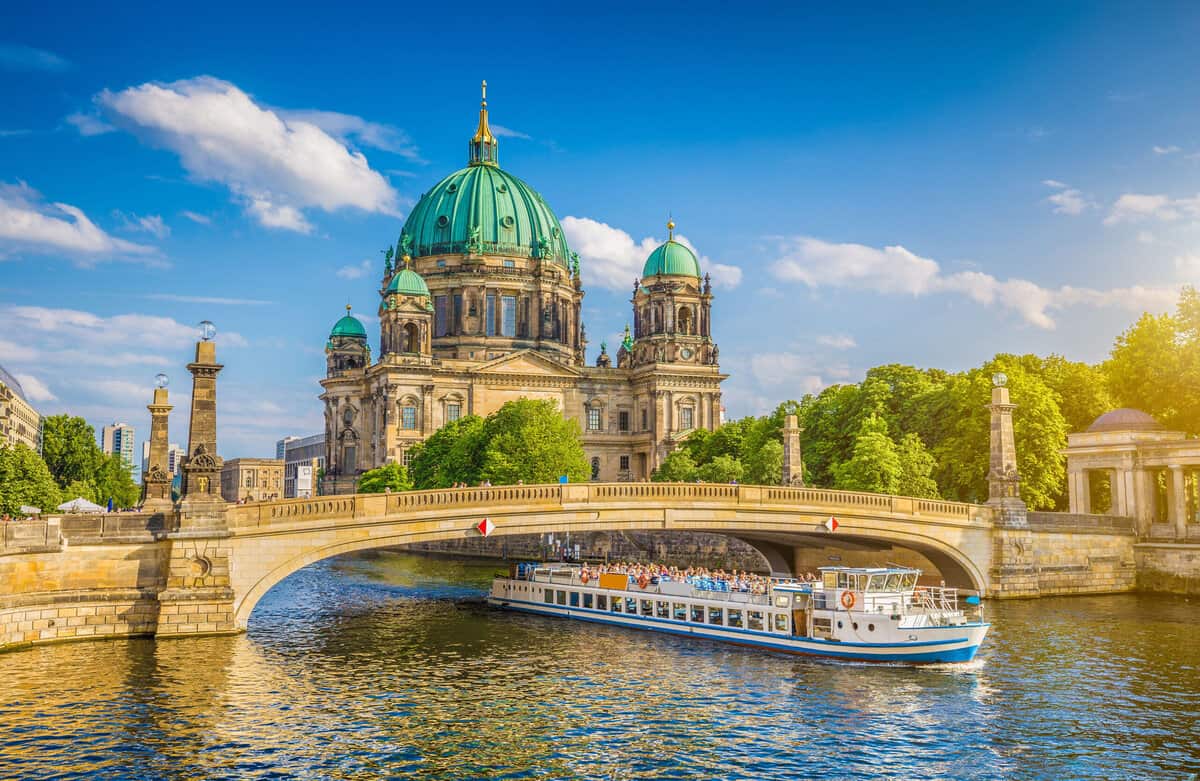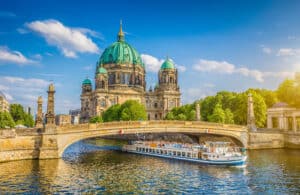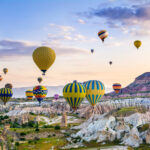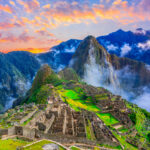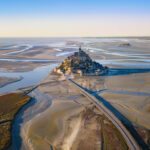Berlin is a city with a rich history and a vibrant cultural scene. It is also a city that can be overwhelming for first-time visitors, with so much to see and do. However, with careful planning and a bit of organization, it is possible to make the most your visit Berlin.
Contents
Must-See Sights
There are many must-see sights that should not be missed on a one-day visit. Some of the top sights to see include:
Brandenburg Gate
The Brandenburg Gate is one of the most iconic landmarks in Berlin, Germany, and a must-see sight for any visitor to the city. The 18th-century monument is a symbol of the city and is considered one of the most important landmarks in Germany.
The Brandenburg Gate was designed by Carl Gotthard Langhans and was built between 1788 and 1791 as a symbol of peace. It is a monumental structure that stands at 26 meters high and 65 meters wide, and is made of sandstone. The gate is adorned with six Doric columns, and at the top of the structure sits a quadriga, a chariot pulled by four horses, which is a symbol of victory.
Throughout history, the Brandenburg Gate has played a significant role in the history of Berlin and Germany. During the Cold War, it stood as a symbol of the division of the city, with the gate on the East Berlin side being closed to the public. However, after the fall of the Berlin Wall in 1989, the gate was once again opened to the public and has since become a symbol of unity and peace.
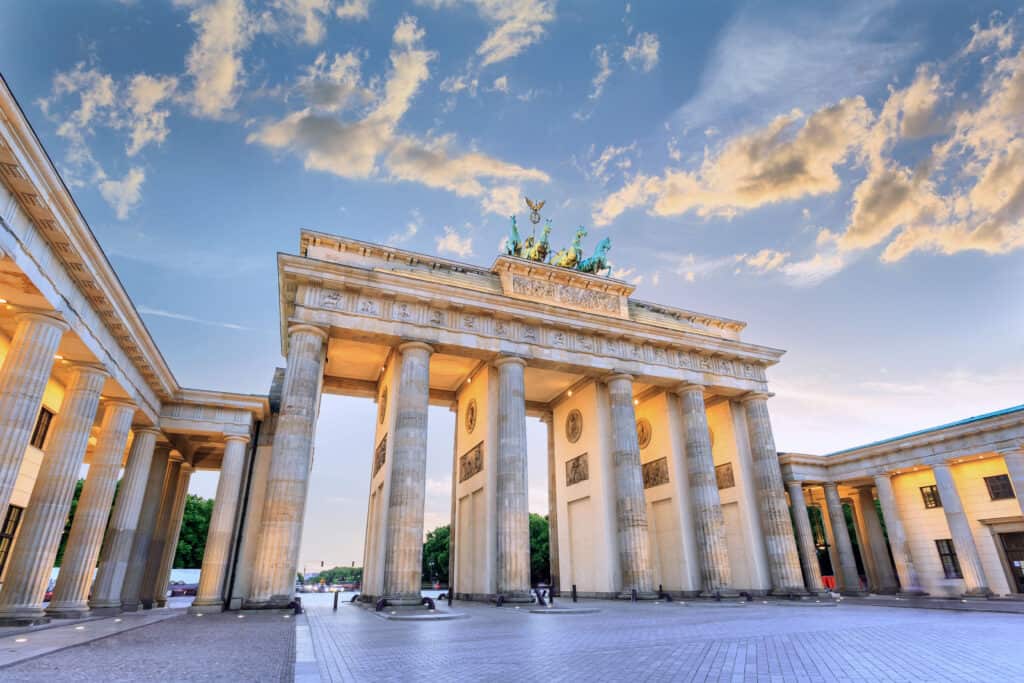
Today, the Brandenburg Gate is a popular tourist destination and is often used as a backdrop for political events and ceremonies. Visitors can walk through the gate and take in the stunning architecture, as well as visit the nearby Brandenburg Gate Museum, which offers a glimpse into the history of the gate and its significance to the city.
Reichstag Building
The Reichstag building is a historical landmark located in Berlin, Germany, and is the home of the German parliament. The building is a must-see sight for any visitor to the city and offers a stunning view of the city from its glass dome.
The Reichstag building was originally built in 1894 to house the German parliament. It was severely damaged in 1933 during a fire, which was later used as a pretext by the Nazis to increase their control over the government. The building was left in ruins for many years, and it wasn’t until after the fall of the Berlin Wall that it was decided to rebuild it.
The reconstruction of the Reichstag building was completed in 1999 and was designed by British architect, Sir Norman Foster. The building has been transformed into a modern and functional parliament, with a spectacular glass dome that offers panoramic views of the city.
Visitors can take a tour of the Reichstag building, which includes a visit to the plenary chamber, the parliamentary offices, and the glass dome. The dome can be accessed via a spiral ramp, and from the top, visitors can enjoy a 360-degree view of the city. The dome is also equipped with an audio guide that provides information about the history of the building and the city.

In addition to the tours, the Reichstag building also houses a restaurant, a parliamentary library, and a visitor center. The visitor center offers exhibitions on the history of the building, the role of the parliament in German society and the history of Berlin.
Museum Island
Museum Island, located in the heart of Berlin, is a group of five world-renowned museums that are a must-see for any visitor interested in art and culture. The island is home to some of the world’s most important collections of art and artifacts and offers a glimpse into the history and culture of civilizations from around the world.
All the museums are easily accessible by public transportation and offer audio guides and guided tours in multiple languages. Visitors can purchase a day pass that allows access to all five museums, allowing to take the time to explore each one in depth.
In addition to the museums, Museum Island also offers a variety of other cultural experiences, including concerts, lectures, and special exhibitions.
Memorial to the Murdered Jews of Europe
The Memorial to the Murdered Jews of Europe, also known as the Holocaust Memorial, is a powerful and thought-provoking monument located in the heart of Berlin, Germany. It is dedicated to the memory of the six million Jews who were murdered during the Holocaust and serves as a reminder of the atrocities committed during this dark period in history.
The Memorial was designed by the American architect Peter Eisenman and the German engineer Buro Happold and was opened in 2005. The monument consists of a field of 2,711 concrete slabs of varying heights, arranged in a grid pattern on a sloping field. The slabs are arranged to create a sense of disorientation, and visitors are invited to walk among them and reflect on the events of the Holocaust.
The Memorial also includes an underground Information Center, which provides historical information about the Holocaust and the persecution of the Jews in Europe. The center features a permanent exhibition that includes photographs, documents, and personal testimonies from survivors of the Holocaust.

The Memorial is located in the heart of Berlin, close to the Brandenburg Gate and other historical landmarks. It is open to visitors year-round and is free to enter. It serves as a place of contemplation and reflection for visitors and is also a place for ceremonies and events that commemorate the victims of the Holocaust.
Alexanderplatz
Alexanderplatz is a popular square located in the heart of Berlin, Germany, and is a must-see destination for any visitor to the city. The square is a major transportation hub and is surrounded by shops, restaurants, and cafes, making it the perfect spot to start exploring the city.
Alexanderplatz was first mentioned in the 14th century and was originally a market square. It has been through many changes throughout its history, including a renovation in the 1960s and 1970s that turned it into a modern shopping and transportation hub.
The square is home to several iconic landmarks, including the Fernsehturm (TV Tower), which offers panoramic views of the city from its observation deck. The Rotes Rathaus (Red City Hall) is also located on the square, and is the city’s town hall and serves as the seat of the mayor.
Alexanderplatz is also home to several shopping centers, including the Alexa shopping center and the Galeria Kaufhof department store. Visitors can also find a variety of restaurants, cafes and street food options in the area, making it a great spot to grab a bite to eat.
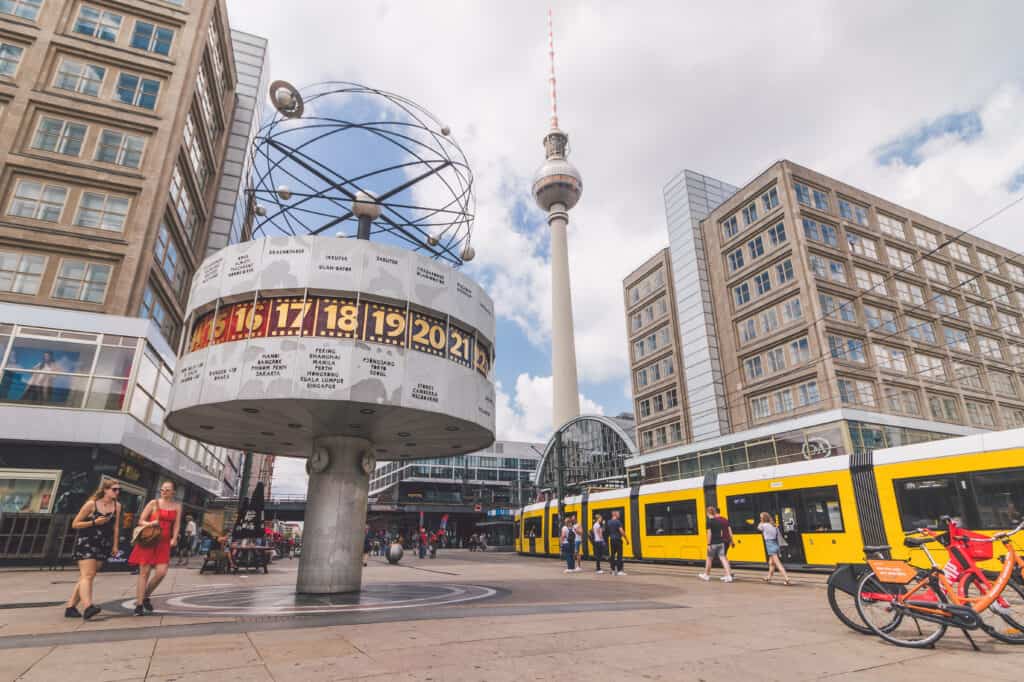 uslatar / Shutterstock.com
uslatar / Shutterstock.comIn addition to its shopping and dining options, Alexanderplatz also has a lively atmosphere and is the site of many events and festivals throughout the year. The square is also a popular meeting place and it is common to see locals and visitors alike enjoying the square’s lively atmosphere.
Gendarmenmarkt
Gendarmenmarkt is a beautiful square located in the heart of Berlin, Germany, and is considered one of the most picturesque spots in the city. The square is home to two cathedrals, the French Cathedral and the German Cathedral, and is a popular destination for tourists and locals alike.
The French Cathedral, also known as the Französischer Dom, was built in the 18th century as a place of worship for the French Huguenot community in Berlin. The German Cathedral, also known as the Deutscher Dom, was built in the same century, and was originally used as a church for German-speaking Protestants.
Both cathedrals were heavily damaged during World War II and were rebuilt in the 1980s. Visitors can now take guided tours of both cathedrals and learn about their history and architecture.
In addition to the cathedrals, Gendarmenmarkt is also home to the Konzerthaus Berlin, a concert hall that hosts a variety of musical and theatrical events. Visitors can also find a variety of restaurants, cafes, and street food options around the square, making it a great spot to grab a bite to eat.
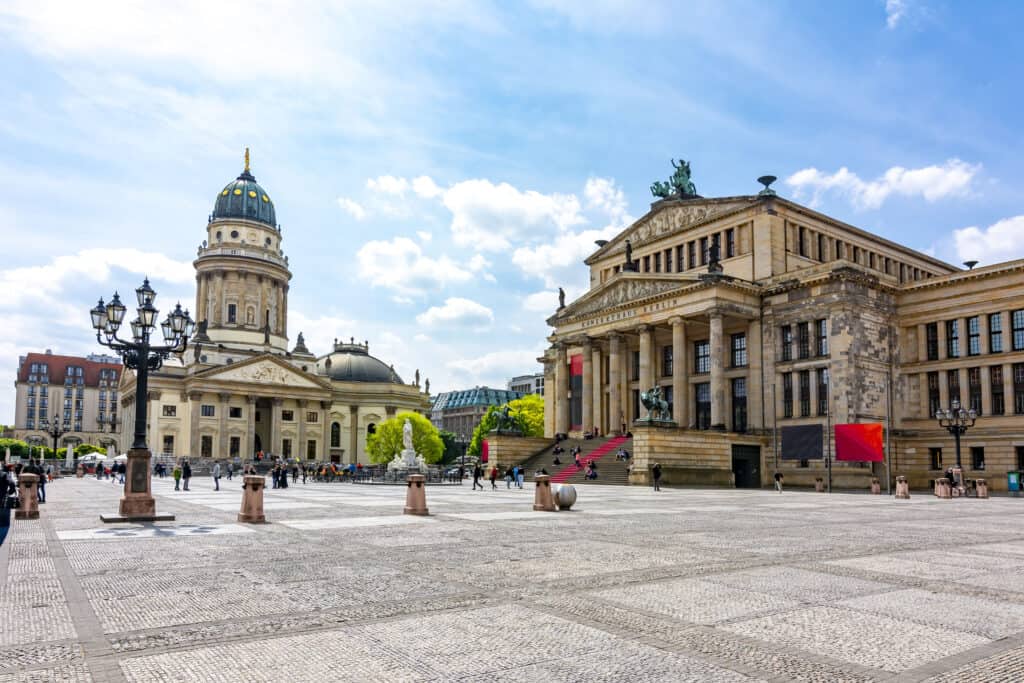
Gendarmenmarkt is also a popular spot for outdoor events, such as Christmas markets and concerts, and it’s a great place to relax and take in the architecture of the city.
Berlin Cathedral
The Berlin Cathedral, also known as the Berliner Dom, is a magnificent church located in the heart of Berlin, Germany, and is one of the most famous landmarks in the city. The cathedral is a must-see destination for any visitor to the city and offers a great view of the city from its dome.
The Berlin Cathedral was built in the early 20th century and was designed in the German Renaissance style. The cathedral is adorned with intricate carvings, frescoes, and stained glass windows, and is considered one of the most beautiful examples of German Renaissance architecture.
Inside the cathedral, visitors can admire the impressive organ, which has more than 7,000 pipes, and the pulpit, which is made of marble and is considered one of the most beautiful in the world. Visitors can also admire the mosaics and frescoes, which depict scenes from the Bible and the history of Berlin.
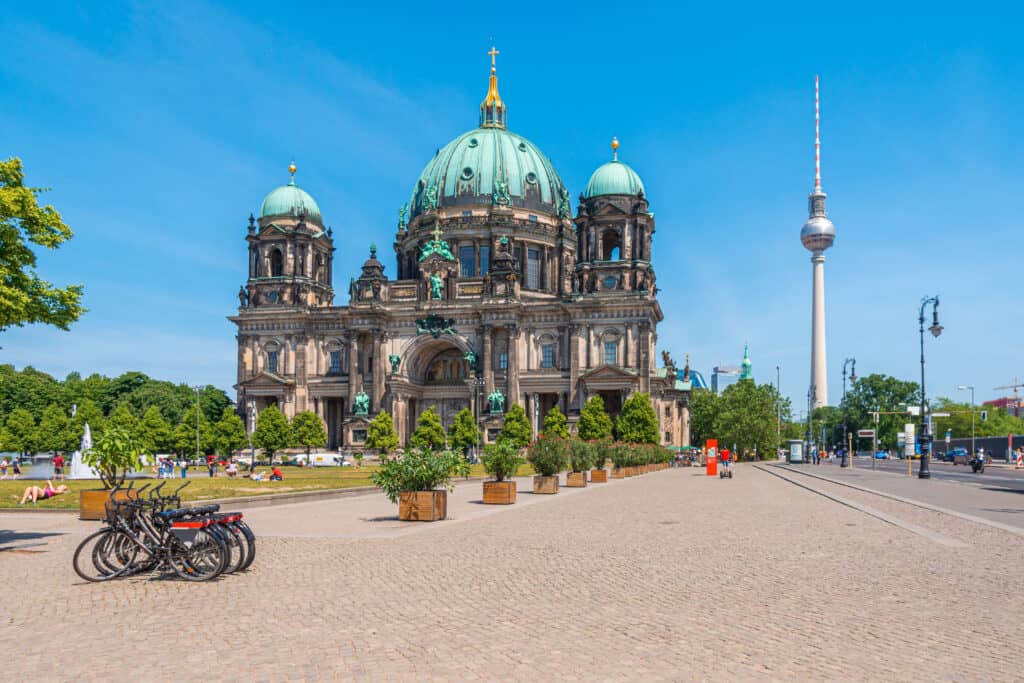
The dome of the Berlin Cathedral offers a panoramic view of the city and can be accessed via a lift or a staircase. From the top, visitors can enjoy a 360-degree view of the city and admire the intricate details of the dome’s frescoes and mosaics.
In addition to its religious significance, the Berlin Cathedral is also an important historical site. It has been the scene of many important events throughout the history of Berlin, including the coronation of Kaiser Wilhelm II, and it was also the site of the state funeral of Kaiser Wilhelm I.
Checkpoint Charlie
Checkpoint Charlie was one of the crossing points between East and West Berlin during the Cold War, and it became a symbol of the division of the city.
Checkpoint Charlie was established in 1961 and was the main crossing point for foreigners, members of the Allied forces, and diplomats. The checkpoint was manned by American and Soviet soldiers, and it was the only point at which foreigners were allowed to cross between East and West Berlin.
Today, Checkpoint Charlie is a museum that offers a fascinating look at the history of the wall and the people who lived in its shadow. The museum features exhibits on the history of the wall, including photographs, documents, and personal testimonies from people who crossed the checkpoint. Visitors can also see original artifacts such as uniforms and equipment used by the border guards during the Cold War.
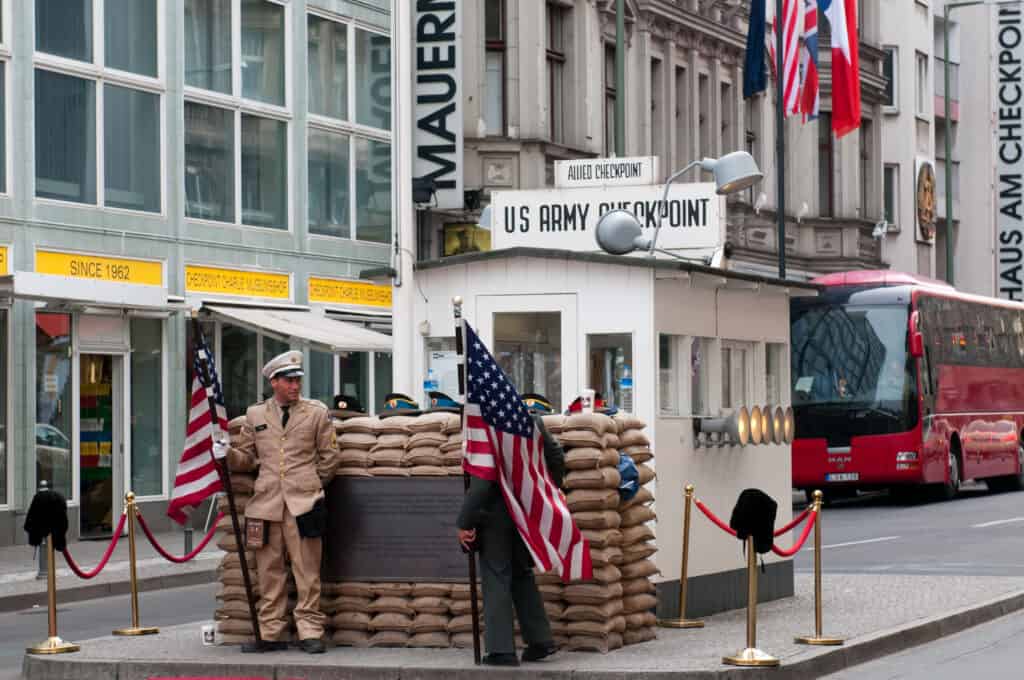 lexan / Shutterstock.com
lexan / Shutterstock.comThe Checkpoint Charlie Museum also covers the history of escapes and escape attempts, the role of the media in the Cold War, and the impact of the wall on the daily lives of the people living in the divided city.
The East Side Gallery
A 10th must-see sight in Berlin that should not be missed is the East Side Gallery. It is the longest remaining stretch of the Berlin Wall, and it is now an open-air gallery displaying over 100 murals painted by artists from all over the world.
The East Side Gallery is located on the banks of the River Spree, in the district of Friedrichshain, and it is a 1.3-kilometer-long section of the wall. The murals on the gallery are a powerful and moving tribute to freedom and the fall of the Berlin Wall and represent the hope and optimism that emerged after the fall of the wall.
 gary718 / Shutterstock.com
gary718 / Shutterstock.comSome of the most famous murals include the “Fraternal Kiss” by Dmitry Vrubel, the “Trabant” by Kani Alavi and the “Hope” by Günther Schaefer. Visitors can walk along the wall and admire the murals, as well as learn more about the history of the Berlin Wall.
The East Side Gallery is a popular destination for both tourists and locals, and it’s a great place to relax and take in the sights and sounds of the city. The gallery is open year-round and is free to visit.
Berlin Wall Memorial
The Berlin Wall Memorial is a must-see sight for anyone interested in the history of the city and the impact of the Cold War on the German people. The memorial is located in the former death strip between East and West Berlin, and offers a glimpse into the dark period when the city was divided by the wall.
The Berlin Wall was built in 1961 to divide East and West Berlin, and stood for 28 years, separating families, friends, and the city itself. The Berlin Wall Memorial is built on a section of the original wall and includes a documentation center, an exhibition on the history of the wall, and a visitor center.
The documentation center houses a collection of photographs, documents, and personal testimonies from people who lived in the shadow of the wall. The exhibition provides an in-depth look at the history of the wall and its impact on the city, as well as the stories of the people who were affected by it.
The Memorial also includes the Chapel of Reconciliation, a modernist church that was built on the site of the former church of Reconciliation, which was destroyed during the construction of the wall. The Chapel serves as a symbol of hope and reconciliation and offers a place for visitors to reflect on the past.
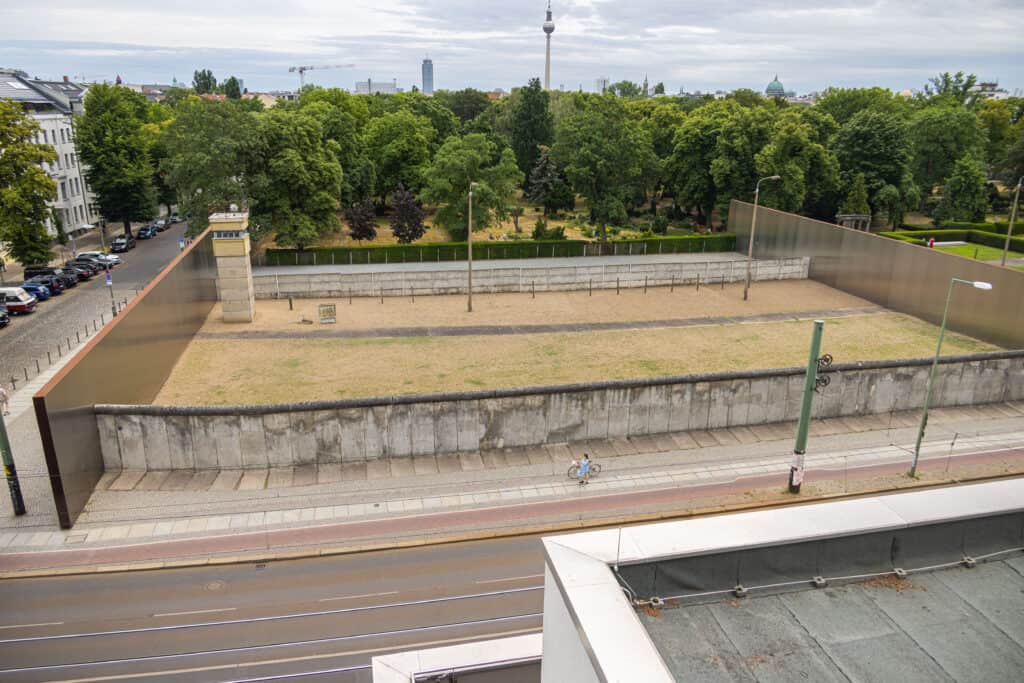 Holger Kleine / Shutterstock.com
Holger Kleine / Shutterstock.comThe Berlin Wall Memorial is a powerful and thought-provoking monument that serves as a reminder of the atrocities committed during the Cold War and the division of the city. Visitors can walk along the original wall, and see the remaining parts of the wall, graffiti, and the preserved watchtowers.
Art and Culture
Berlin is home to a wide range of museums, showcasing a diverse range of art, history, and science.
Museums
When going on a museum tour in Berlin, it can be overwhelming to decide where to start. Here are a few suggestions to help plan your visit:
Start with the Museum Island: The Museum Island is home to five of the city’s most important museums, including the Alte Nationalgalerie, the Pergamon Museum, and the Neues Museum. This is a great starting point for those who want to experience a wide range of art and artifacts from different historical periods.
Focus on a particular theme or period: If you’re particularly interested in a certain period or theme, such as ancient art, modern art, or the history of Berlin, you can focus your museum tour on institutions that specialize in that area. For example, the Pergamon Museum is a great starting point for those interested in ancient art and artifacts, while the New National Gallery is a great place to start for those interested in modern art.
The New National Gallery is dedicated to 20th-century art and features works by artists such as Pablo Picasso, Vincent van Gogh, and Edvard Munch.
The Berlin Museum of Natural History is home to an extensive collection of natural history specimens, including dinosaur fossils, and also features interactive exhibits that explore the natural world.
The DDR Museum is an interactive museum that explores life in East Germany during the Cold War era, and gives visitors a glimpse into everyday life behind the Iron Curtain.
Topography of Terror is a museum built on the site of the former Gestapo and SS headquarters, and it explores the history of the Nazi regime and its atrocities during World War II.
Take a guided tour: Guided tours can be a great way to learn more about the museums and the artifacts they contain. Many museums offer guided tours in different languages, which can make it easier to understand the context of the artifacts on display.
Here is a table that includes information about the prices for visiting some of the most notable museums in Berlin.
| Museum | Adult Ticket (in €) | Child Ticket (in €) | Student Ticket (in €) | Senior Ticket (in €) |
|---|---|---|---|---|
| Alte Nationalgalerie | 12 | Free | 6 | 6 |
| Pergamon Museum | 18 | Free | 9 | 9 |
| New National Gallery | 12 | Free | 6 | 6 |
| Berlin Museum of Natural History | 8 | Free | 4 | 4 |
| DDR Museum | 8 | 4 | 4 | 4 |
| Topography of Terror | Free | Free | Free | Free |
Please note that it is always recommended to check the museum’s website for the most current prices and the availability of discounts. Some museums like Topography of Terror have free admission.
Theaters
Berlin is home to a thriving theater scene, with a wide range of productions, from classic plays to contemporary performances. Some of the most notable theaters in the city include:
- The Berlin State Opera is one of the most renowned opera houses in the world, and it offers a wide range of productions throughout the year, including productions of both classic and contemporary opera.
- The Deutsche Theater is one of the oldest and most respected in Berlin, and it offers a wide range of productions, including plays, operas, and ballets.
- The Schaubühne is known for its contemporary productions and its focus on new plays and experimental theater.
- The Berliner Ensemble was founded by Bertolt Brecht and it is known for its political and socially conscious productions.
- The Maxim Gorki Theater is known for its avant-garde productions and its focus on new plays and experimental theater.
- The Komische Oper is known for its productions of both classic and contemporary opera, as well as its focus on new productions and innovative staging.
Information about the prices for visiting some of the most notable theaters in Berlin:
| Theater | Adult Ticket (in €) | Child Ticket (in €) | Student Ticket (in €) | Senior Ticket (in €) |
|---|---|---|---|---|
| Berlin State Opera | 20 – 200 | 8 – 20 | 10 – 50 | 10 – 50 |
| Deutsche Theater | 10 – 40 | 6 – 12 | 7 – 20 | 7 – 20 |
| Schaubühne | 12 – 30 | 6 – 15 | 8 – 20 | 8 – 20 |
| Berliner Ensemble | 8 – 30 | 5 – 10 | 6 – 15 | 6 – 15 |
| Maxim Gorki Theater | 10 – 25 | 5 – 10 | 7 – 15 | 7 – 15 |
| Komische Oper | 10 – 140 | 5 – 20 | 7 – 50 | 7 – 50 |
Please note that the above table is an estimate of the prices for visiting some of the most notable theaters in Berlin. It is always recommended to check the theater’s website for the most current prices and the availability of discounts.
Comedy and Cabaret
Berlin is known for its vibrant cultural scene and offers a wide range of comedy shows and cabaret performances for visitors to experience. Here are a few suggestions:
- Comedy Clubs: Berlin has a thriving comedy scene, with a wide range of comedy clubs that offer stand-up comedy, improv, and sketch comedy performances. Some popular comedy clubs in the city include the Quatsch Comedy Club, the Comedy Cafe Berlin, and the Comedy Club Berlin.
- Cabaret: Berlin has a rich tradition of cabaret, and there are a number of venues that offer cabaret performances throughout the city. Some popular cabaret venues include the Wintergarten Variete, the Friedrichstadt-Palast, and the Bar Jeder Vernunft.
- Burlesque: Berlin has a growing burlesque scene and some venues offer burlesque shows, these shows combine elements of comedy, theater and sensual performances. Some venues that offer burlesque shows include the Variete Berlin and the Metropol Theater.
- Improv: Berlin has a growing improvisation scene and some venues offer improv shows, these shows are completely improvised and can be a fun and entertaining experience. Some venues that offer improv shows include the Comedy Cafe Berlin and the Improv Comedy Berlin.
These are just a few examples of the wide range of comedy and cabaret performances that are available in Berlin. Visitors can find more information about specific shows, venues and schedules on the internet.
Nightlife
Berlin is famous for its vibrant nightlife, and offers something for everyone, from traditional German pubs to trendy clubs and bars. The city is known for its diversity, creativity and its non-stop party scene, making it a great destination for those looking for a night out on the town.
Berlin-Kreuzberg
Kreuzberg is a neighborhood in Berlin known for its vibrant and alternative nightlife. The area is home to a large number of bars, clubs, and music venues, and it’s a great spot to experience the city’s underground culture.
One of the most popular areas for nightlife in Kreuzberg is the Oranienstraße, which is home to a variety of bars, clubs, and music venues. Visitors can find a variety of bars that cater to different tastes, such as traditional German pubs, trendy bars, and rooftop bars. Some popular bars in the area include the Prater Garten, the Zum Schusterjungen, and the Schleusenkrug.
Kreuzberg is also known for its alternative music scene and is home to a variety of clubs that offer live music, such as the SO36 and the Lido. The SO36 is one of the most popular clubs in the area, and it’s known for its alternative music and its role in the development of the punk scene in Berlin.
Kreuzberg is also home to a variety of trendy bars, such as the Monsieur Claude, the Klunkerkranich, and the Monkey Bar, which offer great views of the city and a relaxed atmosphere.
In addition to bars and clubs, Kreuzberg also offers a variety of other nightlife options, such as comedy clubs, jazz clubs, and rooftop bars. Visitors can also find a variety of street food vendors and street performances in the area, making it a great spot to explore the city’s alternative culture.
Berlin-Friedrichshain
Friedrichshain is a neighborhood in Berlin known for its vibrant nightlife and its focus on techno and electronic music. The area is home to some of the city’s most famous clubs, bars, and music venues and it’s a great spot to experience the city’s alternative and underground culture.
One of the most famous clubs in Friedrichshain is the Berghain, which is considered one of the best techno clubs in the world. The club is located in a former power plant and is known for its dark and industrial atmosphere, as well as its high-quality sound system.
Another popular club in Friedrichshain is the Tresor, which is located in a former department store and is known for its role in the development of techno music in Berlin. The club is also home to a record label and a record store, making it a great spot for techno and electronic music fans.
Friedrichshain is also home to a variety of bars and clubs that offer a more alternative and bohemian atmosphere. Some popular bars and clubs in the area include the Watergate Club, the Suicide Circus, and the Chalet.
Friedrichshain also offers a variety of other nightlife options, such as comedy clubs, jazz clubs, and rooftop bars. Visitors can also find a variety of street food vendors and street performances in the area, making it a great spot to explore the city’s alternative culture.
Other Spots
Berlin’s nightlife is not limited to the neighborhoods of Kreuzberg and Friedrichshain, there are many other areas in the city that offer a variety of nightlife options for visitors. Some other popular areas for nightlife in Berlin include:
- Mitte: This central neighborhood is home to a variety of bars, clubs, and music venues, as well as many restaurants and cafes. Some popular spots in Mitte include the Bar Tausend, the White Trash Fast Food, and the Bar 3.
- Prenzlauer Berg: This neighborhood is known for its bohemian and alternative atmosphere and offers a variety of bars, clubs, and music venues. Some popular spots in Prenzlauer Berg include the Kulturbrauerei, the Monarch, and the Kaffee Burger.
- Neukölln: This neighborhood is known for its diverse and multicultural atmosphere and offers a variety of bars, clubs, and music venues. Some popular spots in Neukölln include the Badeschiff, the Maze, and the Acud Macht Neu.
- Tiergarten: This neighborhood is known for its upscale atmosphere and offers a variety of bars, clubs, and music venues. Some popular spots in Tiergarten include the Watergate Club, the Weekend Club, and the Ritter Butzke.
- Charlottenburg: This neighborhood is known for its upscale atmosphere and offers a variety of bars, clubs, and music venues. Some popular spots in Charlottenburg include the Clärchens Ballhaus, the Tante Emma, and the Lido.
In addition to these neighborhoods, Berlin also offers a variety of other nightlife options such as comedy clubs, jazz clubs, and rooftop bars that can be found throughout the city.
Remember for December – Christmas Market
Berlin has one of Germany’s most beautiful Christmas Markets, these markets are only opened for four weeks during the month of December.
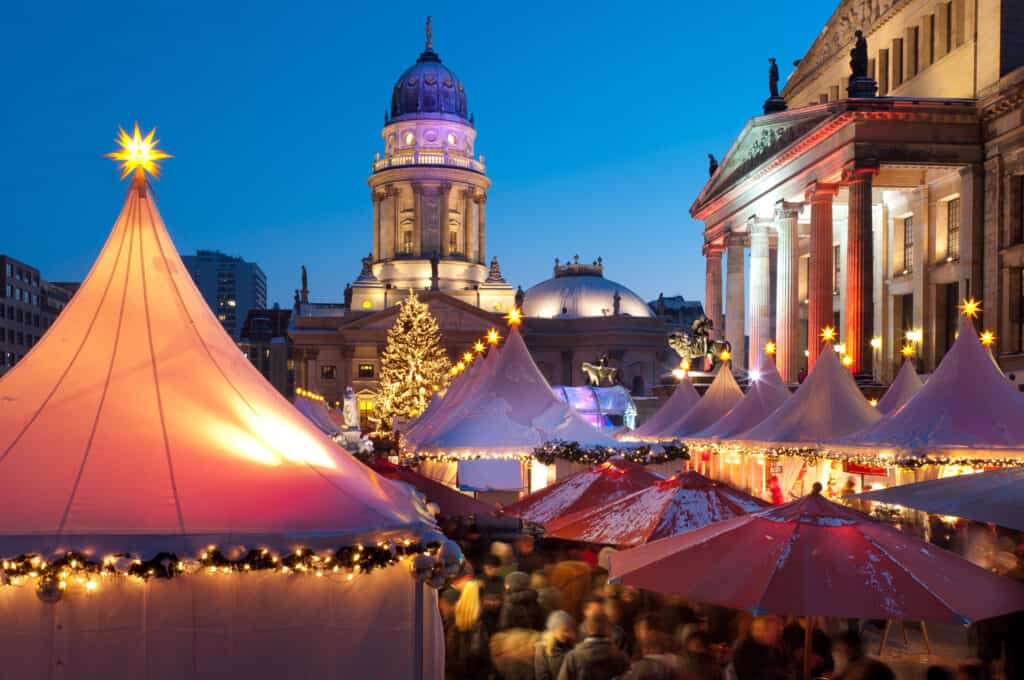
Read more: Visit the famous Christmas markets in Germany
Best ways to get around
Berlin is a large and sprawling city, and getting around can be a bit challenging. However, there are a variety of transportation options available that can make it easy to explore the city.
Public Transportation
Berlin has an extensive public transportation system, including buses, trams, and trains that run frequently and can take you to nearly every corner of the city. The S-Bahn (city rail) and U-Bahn (subway) are the most convenient way to get around, with frequent services and stops at most major tourist attractions.
Bike Rentals
Berlin is a bike-friendly city, with a wide range of bike rental options available. This is a great way to get around and see the city, as it allows you to cover a lot of ground quickly and easily.
Taxis and Ridesharing
Taxis and ridesharing services such as Uber are readily available in Berlin and can be a convenient way to get around, especially during peak travel times.
Walking
Many of the city’s main tourist attractions are located within walking distance of each other, so walking can be a great way to get around and see the city.
Car rental
If you prefer to have a car and explore the city on your own pace, there are many car rental options available in Berlin. Keep in mind that parking can be challenging and the city center is quite congested.
How to get there
| Destination | Distance (km) | Distance (mi) | By Train (h) | By car (h) | By bus (h) |
|---|---|---|---|---|---|
| Cologne | 474 | 295 | 4.75 | 5-6 | 6-7 |
| Frankfurt | 337 | 209 | 3.5 | 4-5 | 5-6 |
| Hanover | 215 | 133 | 2.25 | 2-3 | 3-4 |
| Hamburg | 174 | 108 | 2 | 2-3 | 3-4 |
| Munich | 550 | 342 | 5.5 | 6-7 | 8-9 |
Please note that the above table is an estimate of the journey times to Berlin from various destinations in Germany by car, train, and bus. The times may vary depending on traffic conditions, road works and other factors, it is important to check the schedule and plan ahead.


